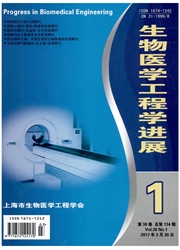

 中文摘要:
中文摘要:
目的深入研究缝合区附近的血流动力学特性,这对于了解内膜增生的发生机制以及提高冠状动脉搭桥畅通率有重要的指导与临床意义。方法通过运用三维重建软件和逆向工程软件从CT医学图像中重建出弯曲冠状动脉模型,并考虑移植管缝合到冠状动脉上时端口的变形。采用有限体积法数值研究的方法,模拟冠状动脉搭桥术中下游缝合区附近的血液流动的流场。结果临床上常出现内膜增生的位置都存在不正常的血流动力学现象,缝合前端和缝合后端都出现了严重的回流现象。结论在冠状动脉旁路移植术中,移值管远端应缝合到曲率较小的冠状动脉上。
 英文摘要:
英文摘要:
Objective To comprehensively study hemodynamic nearby anastomosis, which will be instruc- tive and helpful for understanding the mechanism of intimal hyperplasia and boost coronary artery bypass flow rate. Method With 3D reconstruction software and reverse engineering software, we reconstructed bended coronary artery model from CT medical images. Considering the end of the graft was deformed when graft was sutured to coro- nary artery, we used finite volume method to simulate blood flow nearby anastomosis in coronary artery bypass graft (GABG). Results There were abnormal hemodynamic phenomenon in the positions where endometrial hyper- plasia were often observed in clinical. Serious backflows phenomenon both occured in toe and heel of anastomosis. Conclusion In GABG, far - end of the distal graft should be sutured to coronary artery with small curvature.
 同期刊论文项目
同期刊论文项目
 同项目期刊论文
同项目期刊论文
 期刊信息
期刊信息
